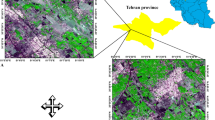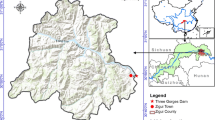Abstract
Scale issue is one of the key issues in landscape ecology and related environmental science. Previous studies have addressed the effects of landscape metrics to changing spatial scale, grain size, and class resolution. However, Minimum mapping unit (MMU) as one of scale issues has not been well investigated. Using a real landscape, this paper examines the effects of changing MMU on landscape metrics. The sensitivity of landscape metrics to changing MMU is also calculated. The results show that changing MMU is different from changing spatial scale and grain size. The paper further provides some criteria or suggestions for selection of landscape metrics in landscape analysis. These findings are crucial for the understanding of the behaviours of landscape metrics across different scales and for selecting the appropriate metrics in landscape analysis or related environmental studies.
Access this chapter
Tax calculation will be finalised at checkout
Purchases are for personal use only
Preview
Unable to display preview. Download preview PDF.
Similar content being viewed by others
References
Turner, M.G., Gardner, R.H., O’Neill, R.V.: Landscape Ecology in Theory and Practice: Pattern and Process, vol. 291. Springer, New York (2001)
Wiens, J.: Spatial scaling in ecology. Functional Ecology 3, 385–397 (1989)
Wu, J., Shen, W., Sun, W., Tueller, P.T.: Empirical patterns of the effects of changing scale on landscape metrics. Landscape Ecology 17, 761–782 (2002)
Leitao, A.B., Ahern, J.: Applying landscape ecological concepts and metrics in sustainable landscape planning. Landscape and Urban Planning 59, 65–93 (2002)
Lausch, A., Herzog, F.: Applicability of landscape metrics for the monitoring of landscape change: issues of scale, resolution and interpretability. Ecological Indicators 2, 3–15 (2002)
Wickham, J.D., Riitters, K.H.: Sensitivity of landscape metrics to pixel size. International Journal of Remote Sensing 16, 3585–3594 (1995)
Turner, M.G.: Landscape ecology: the effect of patterns on process. Annual Review of Ecology and Systematics 20, 171–191 (1989)
Saura, S., Martinez-Millan, J.: Sensitivity of landscape pattern metrics to map spatial extent. Photogrammetric Engineering and Remote Sensing 67(9), 1027–1036 (2001)
Shen, W., Jenerette, G.D., Wu, J., Gardner, R.H.: Evaluating empirical scaling relations of pattern metrics with simulated landscapes. Ecography 27, 459–469 (2004)
Wu, J.: Effects of changing scale on landscape pattern analysis: Scaling relations. Landscape Ecology 19, 125–138 (2004)
Lillesand, T., Kiefer, R.: Remote Sensing and Image Interpretation, vol. 157. John Wiley & Sons, Inc., New York (1994)
Zonneveld, I.S.: The land unit - a fundamental concept in landscape ecology, and its application. Landscape Ecology 3(2), 67–86 (1989)
Davis, W.A., Peet, F.G.: A method of smoothing digital thematic maps. Remote Sensing of Environment 6, 45–49 (1977)
Goodchild, M.F., Quattrochi, D.A.: Scale, multiscaling, remote sensing, and GIS. In: Quattrochi, D.A., Goodchild, M.F. (eds.) Scale in Remote Sensing and GIS, pp. 1–11. CRC Lewis, Boca Raton (1997)
Saura, S.: Effects of minimum mapping unit on land cover data spatial configuration and composition. International Journal of Remote Sensing 23(22), 4853–4880 (2002)
Yu, X.J., Ng, C.N.: Spatial and temporal dynamics of urban sprawl along two urban–rural transects: A case study of Guangzhou, China. Landscape and Urban Planning 79(1), 96–109 (2007)
Bock, M., Xofis, P., Mitchley, J., Rossner, G., Wissen, M.: Object-oriented methods for habitat mapping at multiple scales – Case studies from Northern Germany and Wye Downs, UK. Journal for Nature Conservation 13(2-3), 75–89 (2005)
Asnera, G.P., Keller, M., Pereira, R., Zweeded, J.C.: Remote sensing of selective logging in Amazonia Assessing limitations based on detailed field observations, Landsat ETM+, and textural analysis. Remote Sensing of Environment 80, 483–496 (2002)
Knight, J.F., Lunetta, R.S.: An Experimental Assessment of Minimum Mapping Unit Size. IEEE Transactions on Geoscience and Remote Sensing 41(9), 2132–2134 (2003)
Knight, J.F., Lunetta, R.S.: An experimental assessment of minimum mapping unit size. IEEE Transactions on Geoscience and Remote Sensing 41(9), 2132–2134 (2003)
McGarigal, K., Marks, B.J.: FRAGSTATS: Spatial Pattern Analysis Program for Quantifying Landscape Structure Gen. Tech. Rep. PNW-GTR-351, 122 p. US Department of Agriculture, Forest Service, Pacific Northwest Research Station, Portland (1995)
McCarigal, K., Cushman, S.A., Neel, M.C., Ene, E.: FRAGSTATS: Spatial Pattern Analysis Program for Categorical Maps, Version 3.0. University of Massachusetts, Amherst, MA (2002)
McGarigal, K., Cushman, S.A., Neel, M.C., Ene, E.: FRAGSTATS: Spatial Pattern Analysis Program for Categorical Maps. Computer software program produced by the authors at the University of Massachusetts, Amherst (2002), www.umass.edu/landeco/research/fragstats/fragstats.html
Baldwin, D.J.B., Weaver, K., Schnekenburger, F., Perera, A.H.: Sensitivity of landscape pattern indices to input data characteristics on real landscapes: implications for their use in natural disturbance emulation. Landscape Ecology 19(3), 255–271 (2004)
Herold, M., Scepan, J., Clarke, K.C.: The use of remote sensing and landscape metrics to describe structures and changes in urban land uses. Environment and Planning A 34, 1443–1458 (2002)
Forman, R.T.T., Godron, M.: Landscape Ecology. Wiley and Sons, New York (1986)
Sadler, B.: From environmental assessment to sustainability appraisal. In: Environmental Assessment Yearbook 2002 (2002)
Saura, S.: Effects of remote sensor spatial resolution and data aggregation on selected fragmentation indices. Landscape Ecology 19(2), 197–209 (2004)
Hargis, C.D., Bissonette, J., David, J.L.: The behavior of landscape metrics commonly used in the study of habitat fragmentation. Landscape Ecology 13, 167–186 (1998)
O’Neill, R.V., Hunsaker, C.T., Jones, K.B., Riitters, K.H., Wickham, J.D., Schwartz, P.M., Goodman, I.A., Jackson, B.L., Baillargeon, W.S.: Monitoring environmental quality at the landscape scale. BioScience 47(8), 513–520 (1997)
Yue, T.X., Haber, W., Herzog, F., Cheng, T., Zhang, H.Q., Wu, Q.H.: Models for DLU strategy and their applications. Ekologia 17(suppl. 1), 118–128 (1998)
Herzog, F., Lausch, A.: Supplementing land-use statistics with landscape metrics: Some methodological considerations. Environmental Monitoring and Assessment 72, 37–50 (2001)
Turner, M.G., O’Neill, R.V., Gardner, R.H., Milne, B.T.: Effects of changing spatial scale on the analysis of landscape pattern. Landscape Ecology 3, 153–162 (1989b)
Trani, M.K., Giles, J.R.H.: An analysis of deforestation: metrics used to describe pattern change. Forest Ecology and Management 114, 459–470 (1999)
Griffith, J.A., Martinko, E.A., Price, K.P.: Landscape structure analysis of Kansas at three scales. Landscape and Urban Planning 52, 45–61 (2000)
Liu, Y.B., Nishiyama, S., Kusaka, T.: Examining landscape dynamics at a watershed scale using Landsat TM imagery for detection of wintering hooded crane decline in Yashiro, Japan. Environmental Management 31(3), 365–376 (2003)
Herold, M., Goldstein, N.C., Clarke, K.C.: The spatiotemporal form of urban growth: measurement, analysis and modeling. Remote Sensing of Environment 86, 286–302 (2003)
Bock, M., Xofis, P., Mitchley, J., Rossner, G., Wissen, M.: Object-oriented methods for habitat mapping at multiple scale - case studies from Northern Germany and Wye Downs, UK. Journal for Nature Conservation 13, 75–89 (2005)
Burel, F., Baudry, J.: Landscape Ecology: Concepts, Methods and Applications. Plymouth, Science Publishers, Enfield (2003)
Author information
Authors and Affiliations
Editor information
Editors and Affiliations
Rights and permissions
Copyright information
© 2013 Springer-Verlag Berlin Heidelberg
About this paper
Cite this paper
Ng, C., Yu, X., Xie, Y., Yang, J. (2013). The Behaviors of Landscape Metrics to Changing MMU and Suggestions for Landscape Analysis. In: Bian, F., Xie, Y., Cui, X., Zeng, Y. (eds) Geo-Informatics in Resource Management and Sustainable Ecosystem. GRMSE 2013. Communications in Computer and Information Science, vol 399. Springer, Berlin, Heidelberg. https://doi.org/10.1007/978-3-642-41908-9_59
Download citation
DOI: https://doi.org/10.1007/978-3-642-41908-9_59
Publisher Name: Springer, Berlin, Heidelberg
Print ISBN: 978-3-642-41907-2
Online ISBN: 978-3-642-41908-9
eBook Packages: Computer ScienceComputer Science (R0)




